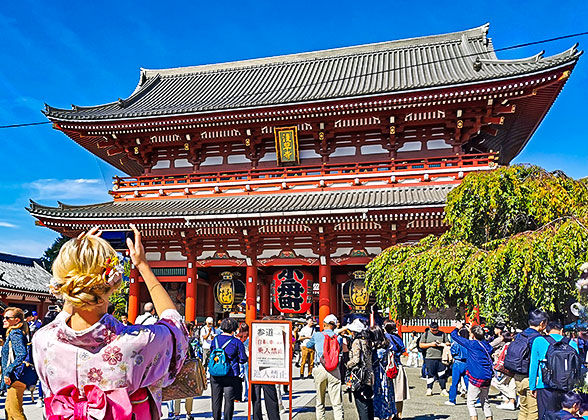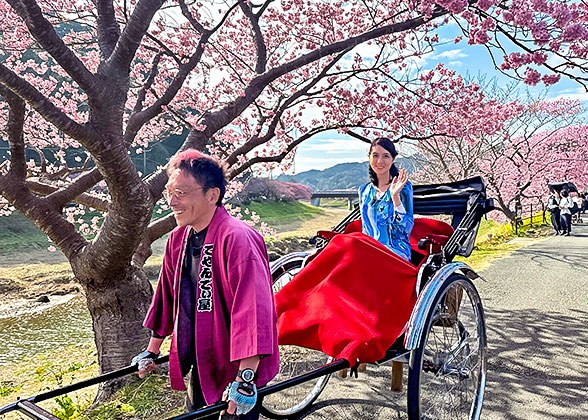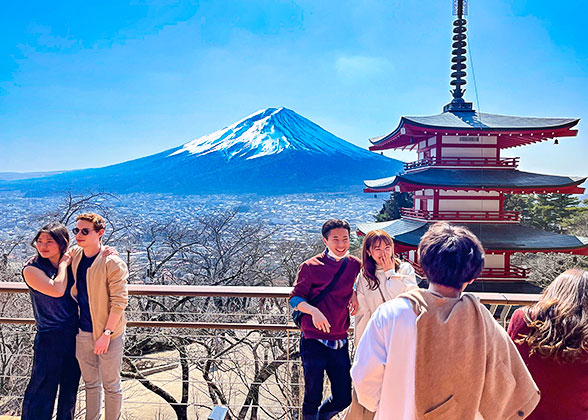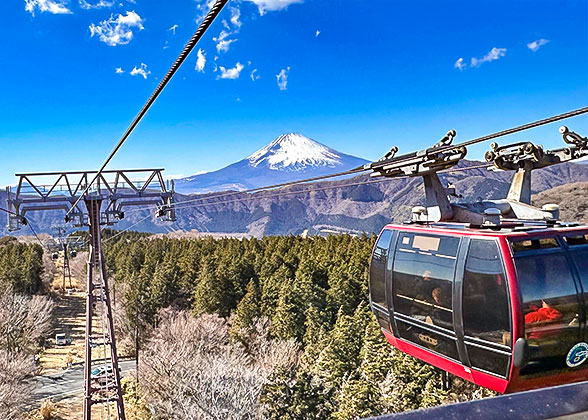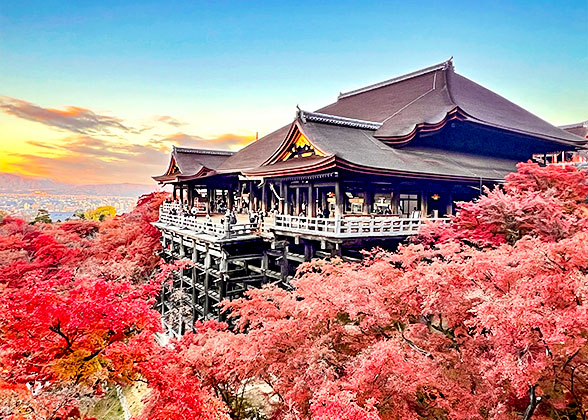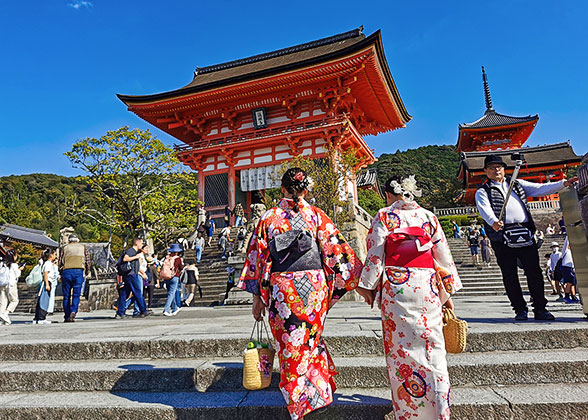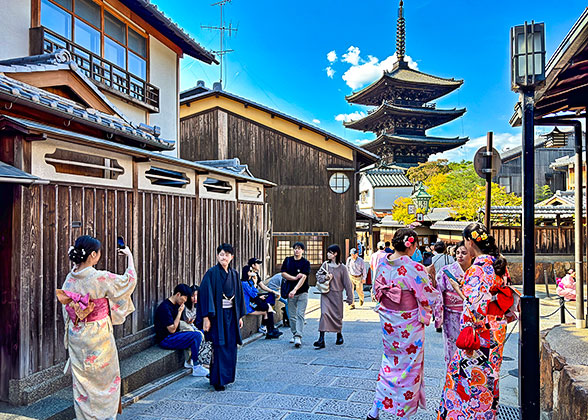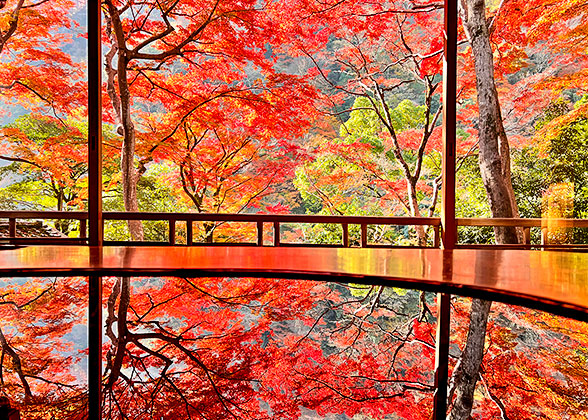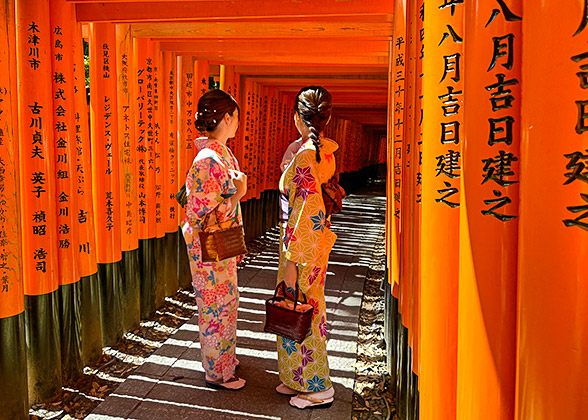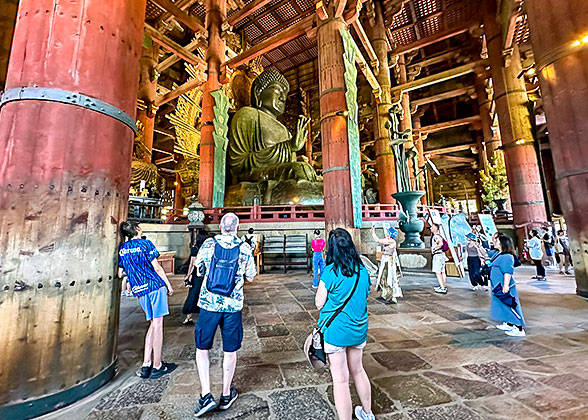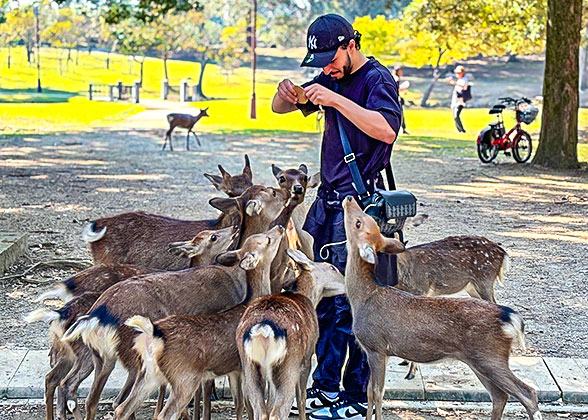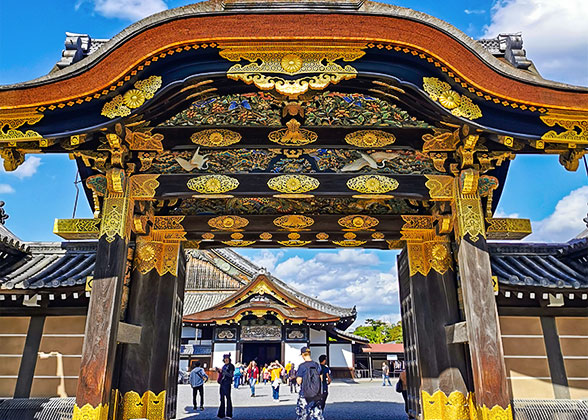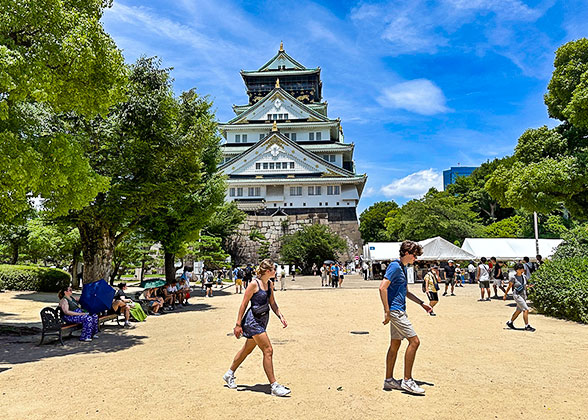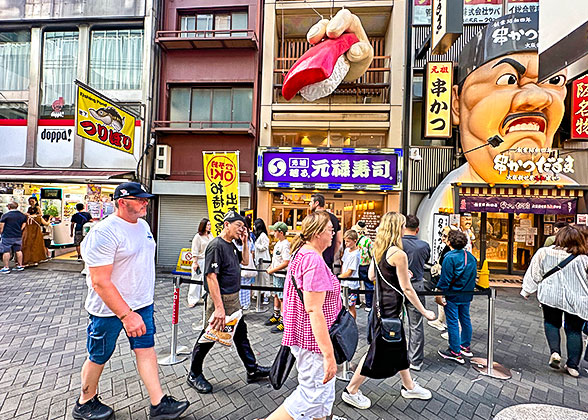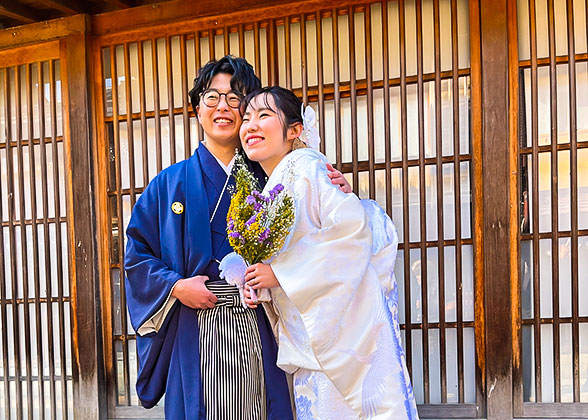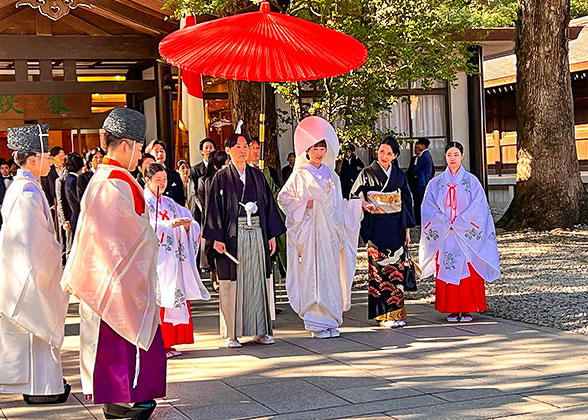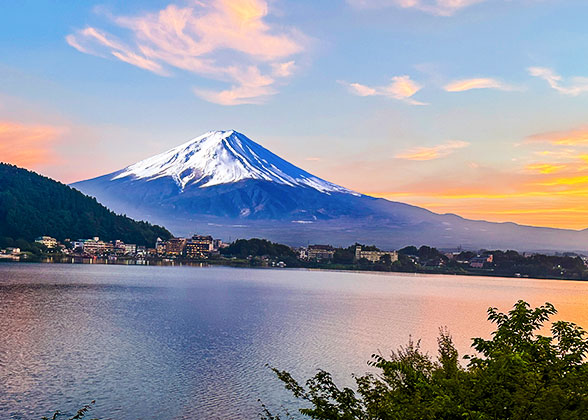Day 1: Tokyo Airport Pick-up by Shared Car
Welcome to join our 7 days Japan group tour! Upon your arrival in Tokyo, we will meet you in the airport’s arrival hall and escort you to a downtown hotel by shared car. Kindly note that shared cars run until 20:30. If you arrive late and are unable to use this service, we will refund your fee. Please arrange your own transfer to the hotel or book a private pickup with us.
► Airport to Hotel Transfer for Your Reference
1. From Narita Airport: Take the Keisei Narita Skyaccess to Ningyocho Station in 70 minutes, then transfer to the Hibiya Line, and get off at Kayabacho Station. Exit from Exit 3 to reach the 3-star hotel. Alternatively, directly to Takaracho Station, and walk for 8 minutes to the 4-star hotel. A taxi costs USD 210-250.
2. From Haneda Airport: Spend over half an hour on the Keikyu Airport Line to Takaracho Station, then walk 7 minutes to our 4-star hotel; or go to Higashi-ginza Station, transfer to the Hibiya Line, and arrive at Kayabacho Station in about 5 minutes to reach the 3-star hotel. A taxi costs USD 90-110.
Taxis in Japan are costly, but if you’re arriving late at night, have heavy luggage, or are traveling with 3 or more companions, you may want to consider taking a taxi, as it’s a convenient and quick option.
|
Day 2: Tokyo: Tsukiji Outer Market, Meiji Jingu Shrine, Imperial Palace, Senso-ji Temple
Your guide will meet you at your hotel lobby in the morning, and today’s exciting city tour with Tokyo’s efficient public transport begins at the Tsukiji Outer Market, which has been open since 1935. Known as “Tokyo’s Kitchen,” the market is home to over 400 stores and comes alive each day at dawn. Taste traditional Japanese snacks, such as tamagoyaki omelets, if you like, and enjoy the lively market atmosphere. Let’s leave behind the hustle and head to the sacred Meiji Jingu Shrine. Located in a vast artificial forest between Shinjuku and Shibuya, it enshrines Emperor Meiji (1852-1912), who led Japan’s modernization, and his empress. Walking along the misty forest trails will make you forget you’re in the middle of Tokyo’s busiest districts. If you’re visiting a Japanese shrine for the first time, Meiji Jingu Shrine offers a perfect experience. Abundant informative signs in English, along with our knowledgeable guide, will help you understand and participate in traditional shrine rituals, such as praying in the main hall and writing wishes on votive tablets. Besides, since the shrine is popular for traditional weddings, you might witness a Japanese wedding ceremony with the bride in a white kimono and the groom in an all-black kimono. Senso-ji Temple, Tokyo Cherry Blossom in Japan
Then, follow your guide to another peaceful oasis in central Tokyo, the Imperial Palace, which has been the residence of the Japanese royal family since Emperor Meiji moved the capital to Tokyo in 1868. The historic structures, such as Nijubashi Bridge and Fujimi Tower, preserved in the Imperial Palace Outer Garden, allow us to enjoy the beauty of the exquisite Japanese garden while also offering a glimpse of 17th-century Edo-style architecture. From late March to early April each year, this spot is ideal for viewing cherry blossoms, enhanced by the historic charm of the remaining ancient moat and gates. In the afternoon, we’ll visit the Senso-ji Temple. Unlike typical solemn and quiet religious sites, we’ll first arrive at the busy Nakamise-dori Street after passing through the Kaminarimon Gate with a large lantern. On the crowded street lined with shops selling various traditional Japanese snacks, including matcha ice cream, strawberry daifuku (stuffed mochi), oden (fishcake stew), and taiyaki (fish-shaped cake), you can see tourists dressed in kimonos taking pictures everywhere. This close interweaving and harmonious coexistence of religion and commerce, as well as sacredness and secularity, enables us to experience the distinctive Japanese temple culture. At the end of the street, where the Tokyo Skytree is visible in the distance, you’ll naturally gravitate toward the main hall of Senso-ji Temple and its five-story pagoda, both vividly vermilion, appearing solemn yet glorious. Finally, the guide will escort you back to the hotel. Have a good rest for tomorrow’s Hakone tour. Meals: Breakfast
|
Day 3: Tokyo-Hakone Round Trip: Mt. Fuji, Owakudani Valley & Lake Ashi Cruise
This morning, your guide will pick you up at your hotel, and our Hakone tour begins with a bullet train ride to Odawara. From there, we’ll transfer to the Hakone Tozan Train, Japan’s oldest mountain railway, which passes over many bridges and through tunnels as it climbs the Hakone Mountains. The scenery outside the window is especially stunning in June and July, when thousands of hydrangeas bloom along the tracks. After arriving at Sounzan Station, follow your guide to ride the ropeway to Owakudani Valley, a crater area formed when Mount Hakone erupted about 3,000 years ago, which remains an active volcano today. From the ropeway, you can see the barren mountainside with smoke and steaming vents. Standing on the observation deck, the smell of sulfur, along with the taste of a famous black egg cooked in the Owakudani hot springs, creates a multi-sensory experience of the geothermal landscape. On a clear day, you can also enjoy a mesmerizing view of faraway snow-capped Mt. Fuji from here, as well as from the subsequent ropeway to Lake Ashi. As we reach Togendai Port on Lake Ashi, your guide will join you for a roughly 30-minute pirate ship cruise to enjoy the scenic views of Hakone - the sparkling lake, majestic Mt. Fuji, and the red Hakone Shrine Peace Torii by the water. In the 17th century, people used Mt. Fuji as a weather indicator: it’s said that when a conical-hat-shaped cloud forms above Mt. Fuji, it signals bad weather, and rain or snow may be coming; if two or more layers of such clouds appear, strong winds and heavy rain are expected, prompting locals to stay indoors. After completing all the visits in Hakone, your guide will escort you on a train ride back to your hotel in Tokyo. ★ Special Date Exchange Service for Better Viewing Mt. FujiSince visibility around Mt. Fuji heavily depends on the weather, with only about 80 days visible per year, we offer a unique date-exchange service that your guide can help schedule for the best viewing day based on the weather forecast during your two-day stay in Tokyo. While such last-minute adjustments are more cumbersome than setting a fixed itinerary, we are the only Japan tour operator offering this service, aiming to increase your chances of seeing Mt. Fuji by 50%. Therefore, please understand that reserved tickets for express or bullet trains, which we will prioritize but require booking at least one month in advance, will be hard to secure. However, outside peak season, there’s only about a 5% chance of standing with non-reserved tickets. We believe it’s worth both of our efforts to view Mt. Fuji unless both days are cloudy. Meals: Breakfast
|
Day 4: Tokyo - Kyoto: Golden Pavilion, Pure Water Temple & Gion Walking Tour
Ninenzaka and Sannenzaka This morning, you’ll need to take a bullet train to Kyoto on your own, with tickets reserved and provided by us. If your luggage is heavy, consider asking the guide to help arrange a paid delivery service to send your luggage to Kyoto, which usually takes two days to arrive. Please manage your own way to Tokyo Station first, either by walking 7 minutes from the 4-star hotel or by taking a 3-minute walk to Kayabacho Station from the 3-star hotel, then riding the Tozai Line to Otemachi Station, and walking 3 minutes to your destination. After arriving in 2.5 hours, your Kyoto guide will pick you up at the railway station platform, and accompany you to check into the hotel.
Ready to explore the thousand-year-old capital? Our first stop is the Temple of the Golden Pavilion, built as a residence for shogun Ashikaga Yoshimitsu (1358-1408). After his death, according to his will, the courtyard was converted into a Zen temple and named after his Buddhist name. Upon entering, your eyes will be drawn deep into the magnificent Relic Hall, whose top two floors are covered in gold, earning it the name Golden Pavilion. If you look at the roof, you’ll see a gold-plated phoenix statue standing there, shining brightly in the sun, symbolizing eternal life and power.
Next, we’ll visit the Pure Water Temple, Kyoto’s oldest temple, located on Mount Otowa. As you walk along the Sannenzaka and Ninenzaka slopes, passing charming shops and traditional teahouses, the excitement builds as the winding paths lead up to the main hall of the temple. From its iconic suspended wooden stage, you can enjoy a scenic view of the city, and behind it, don’t miss the Jishujinja Shrine to pray for happy love. In front of the shrine, two large rocks stand; it’s said that if you can reach from one to the other with your eyes closed, you’ll find true love. Pure Water Temple, Kyoto Pure Water Temple, Kyoto
Leaving the temple, let’s enjoy a walk through Gion, Kyoto’s most charming neighborhood, filled with quiet, elegant Japanese townhouses, and photograph the striking vermilion buildings of the centuries-old Yasaka Shrine. As today’s tour ends here, the guide will escort you back to the hotel, or you can continue your own exploration of Gion’s nightlife freely.
► Insider Tips: Meet Real Geishas on Your Own
Walk northwest for about 10 minutes from Yasaka Shrine to the intersection of Hanamikoji Street and Tominagacho Street, where the under-the-radar alleys are lined with upscale restaurants and teahouses with curtain-covered doors, creating a mysterious vibe. After 8:30 PM, you can see authentic geishas dressed in kimonos with elaborate makeup coming and going as they prepare to perform and entertain guests in teahouses. To photograph their elegant figures, avoid facing them directly, as it might be considered offensive. Instead, try capturing them from a distance with a telephoto lens. To make your own way back, walk 3 minutes to Shijo Keihan-mae Station, take the 207 City Bus for 11 stops (23 minutes) to Subway Kujo Station, then walk 3 minutes to your hotel. Alternatively, you can take a 15-minute taxi directly.
Meals: Breakfast Sannezaka Path, Kyoto Japan in Autumn
|
Day 5: Kyoto Fushimi Inari Shrine, Nara Tour with World Heritage & Deer Encounters, Back to Kyoto
After breakfast, your guide will pick you up at the hotel and accompany you to visit the Fushimi Inari Shrine. Considered the most important shrine for ordinary people in Japan seeking happiness, it is said there are over 30,000 Inari Shrines across the country, with Fushimi Inari Shrine as the headquarters. For 1,300 years, it has gathered countless wishes for a good harvest, business prosperity, family safety, and the fulfillment of many other dreams. The Senbon Torii we walk through was donated by people who prayed for their wishes to come true or to show gratitude for wishes that have been fulfilled. It consists of about 10,000 vermilion torii gates, built in a row on the mountainside, and has been drawing a steady flow of tourists to take photos. Afterward, go with your guide to Nara by train. Since feeding the deer is probably the first thing that springs to mind when it comes to Nara, we’ll first arrive at Nara Park, home to over 1,000 free-roaming deer. The deer in Nara have long been regarded as messengers of the gods. In the past, killing one could lead to the death penalty. Legend tells of a shop owner in Nara who woke up one morning to find a dead deer outside his shop. Afraid of punishment, he secretly moved the deer to the door of the next shop. Interestingly, the next shop owner followed suit after seeing the dead deer, passing it along to several other shops. The person who was finally caught and executed was a shop owner who often overslept. Since then, all shop owners in Nara have developed the habit of opening their shops early. Fushimi Inari Shrine, Kyoto Great Eastern Temple, Nara
Next, let’s visit the Great Eastern Temple. Built in 747 AD when Emperor Shomu promoted Buddhism to protect the country, this temple was designed to be impressive, showcasing the power, nobility, and piety of the Japanese royal family. The construction of the Vairocana Buddha Statue and the Great Buddha Hall took ten years, used 499 tons of copper, and involved 2.6 million people, including Japan’s top artisans skilled in advanced construction techniques. At that time, all Japanese citizens were required to pay a special tax for the building of the Great Eastern Temple. Then, walk along the old forest-shaded trail to the Kasuga Taisha Shrine, where you can see the most lanterns of any shrine in Japan - around 2,000 stone lanterns and 1,000 hanging copper lanterns - lined along the approach and the corridor. Most of them were donated by former nobles and military leaders, reflecting the shrine’s deep history and enduring popularity. During the Festivals of Ten Thousand Lanterns, held annually in early February and mid-August, all 3,000 lanterns at the shrine are lit at night, creating a magical and dreamlike scene. Later, the guide will accompany you to visit Goryo Shrine, a small shrine well-known among locals for praying for a good marriage, located in the old alleys of Naramachi neighborhood. Keep exploring the traditional district, and we’ll stop at Naramachi Lattice House, which perfectly replicates the style of Nara townhouses from the late 17th to the 18th century. It appears very narrow from the front and is called an eel bed due to its slim, elongated shape, but it’s actually quite deep. Why is it built this way? At that time, houses were taxed based on their width facing the street, so property owners built narrow yet deep townhouses that served both as homes and businesses to lower their taxes. If you love Japanese architecture, you’ll want to spend more time here and experience the wisdom and charm of Nara’s nostalgic townhouse life. In the end, your guide will accompany you on the return train ride to Kyoto. Meals: Breakfast Meet Deer in Nara Park Nijo Castle, Kyoto
|
Day 6: Kyoto Nijo Castle, Train to Osaka, Visit Osaka Castle, Dotonbori & Shinsaibashi
Today, we’ll first visit the Nijo Castle to witness the grandeur of Japan’s samurai regime. As the Kyoto residence of several generations of Tokugawa shoguns, Nijo Castle was the most luxurious and impressive complex in Japan from 17th century to 19th century, especially its lavishly appointed Ninomaru Palace. Additionally, the murals and decorations in various reception rooms were carefully selected to emphasize the shoguns’ power and prestige. For example, in the highest diplomatic chamber, a tiger painting was created using elements of Chinese art and the imagination of tiger lairs. Since Japan did not have tigers at that time, it’s likely that when lords and imperial envoys from across the country saw such a tiger, only in legend, at Nijo Castle, they would submit themselves to the unparalleled resources and authority of the Tokugawa shogunate. For the rest of the day, your guided tour will continue with a quick train ride to Osaka. Once there, follow your guide to visit Osaka Castle, built in 1583 by Toyotomi Hideyoshi, known as the “Japanese Napoleon”. Unfortunately, the main tower of Osaka Castle has been destroyed on several occasions due to wars or lightning strikes. The elegant appearance and color scheme of the one we see today were rebuilt in 1931, making us forget that it was once a military fortification. Ascending the main tower, you can learn about the historical changes of Osaka Castle through the displayed cultural relics and enjoy a panoramic view of Osaka’s modern cityscape. In the late afternoon, we’ll arrive at Dotonbori and Shinsaibashi, Osaka’s liveliest areas for dining and shopping. Dotonbori at dusk looks like an open-air art gallery of advertisements, with large food-shaped signs sparking endless imagination of deliciousness. Tucked away in this busy district is a tranquil Hozen-ji Temple, where you can experience a unique way of praying: scoop water and sprinkle it onto the deity’s statue. After a relaxed walk, your guide will escort you back to the hotel, or you’re encouraged to keep exploring on your own by trying crab hot pot, crab sashimi, crab sushi, takoyaki, and various skewers! After dining in Dotonbori and browsing along Shinsaibashi Street for your favorite souvenirs, you can easily return to your hotel, which is just a 10-minute walk from Shinsaibashi. Meals: Breakfast
|
Day 7: Departure from Osaka
As your tour comes to an end today, please check out and proceed to Osaka Kansai Airport on your own. Walking around 5 minutes from either the 3- or 4-star hotel is Shinsaibashi Station, where you can ride the Midosuji Line to Namba Station, and from there, the Nankai-Limited Express will take you to the airport in about 40 minutes. A taxi from your hotel to the airport costs USD 110-140 and may exceed USD 170 during peak congestion periods (7:30-9:30, 17:00-19:00). Wish you a pleasant journey home!
* If you need to return to Tokyo for your following flight, we can help you book train or plane tickets.
If you’re interested in exploring more cities like Kobe, Hiroshima, Kanazawa, Kumamoto, or traveling across China, Japan, and South Korea, we offer both mini-group and private tours for you to choose from. Of course, we can also customize an itinerary to meet your specific needs. Feel free to contact our travel consultants.
► Recommended Site to Spend Your Free Time in Osaka
You can visit the 170-year-old Kuromon Market with a quick 10-minute taxi ride. Formerly known as the “Kitchen of Osaka,” it offers a wide variety of Japanese seasonal ingredients and snacks, including classic takoyaki and grilled seafood. However, the market has become one of the most expensive dining options in Osaka due to an influx of tourists. If you want to try something cost-effective, a century-old soy milk shop reputed to serve the best soy milk in the Kansai region is a good choice.
Meals: Breakfast
|

